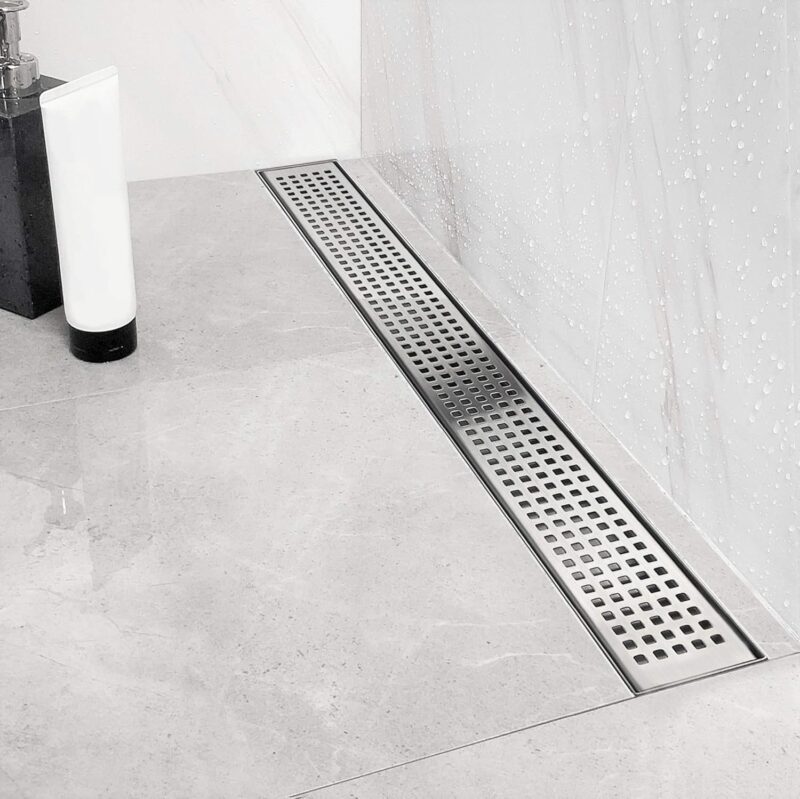Whenever you have a bathroom to design, the type of shower drain picked can be as important as choosing between tile types, fixtures, or layouts. From the top choices, linear and point shower drains have unique advantages according to space and personal needs. A seamless design right to functionality can improve both the looks and functionality of your bathroom with the right drain.
This article aims to provide comprehensive coverage of everything one should know about these two types of drains, from their characteristics to installation requirements and how they can contribute to a quality wet room shower.
Shower drain role in a modern bathroom

A shower drain is not just about draining the water; it’s about safety, efficiency, and aesthetics in your bathroom. Good drainage helps avoid puddles of water that could destroy your flooring and cause slipping. Whether it’s a small shower renovation or the building of a luxury wet room, choosing the right drain is critical.
The modern shower drain has both functionality and a sense of style. It keeps one’s surroundings clean and tidy, regulates the flow of water, and gives new freshness to your bathroom.
Wet room shower drains: sleek, modern solution
What is a linear drain? Linear drains, also called channel drains, are long, narrow drains designed to catch water along a straight line. They’ve become popular for wet room showers and modern bathrooms because of their sleek, seamless look. Linear drains can be set against the wall or down the length of the floor for functionality and style.
Features of linear drains
Size and range: there are linear drains of varied sizes to fit the many bathroom formats. They are ideal for large bathrooms where they would be able to take huge water flow.
Aesthetic appeal: linear drains are available in black, bronze, or brushed steel finishes to easily match or complement the style of your bathroom.
Durable construction: the drain is manufactured from quality materials, such as stainless steel, that do not easily corrode or wear out.
Filter and frame: most of the linear drains come equipped with a filter and frame to make cleaning and servicing really easy.
Advantages of linear drains

Accessibility design: linear drains are ideal and efficient for barrier-free or level-entry shower designs for people with mobility issues.
Water flow efficiency: their extended length allows for a large amount of water to pass through, which is excellent for rainfall shower heads or multiple shower outlets.
Flexible placement: these drains can be installed near a wall, at the center of the shower, or even along the doorway, offering great flexibility.
Linear drains are especially helpful for bathrooms with a single-direction slope. They create a smooth flow, ensuring water doesn’t accumulate anywhere on the floor.
Point drains: traditional and versatile

What are point shower drains? The point shower drains are square or round and are normally installed at the lowest part of the floor. They are good for bathrooms with slopes in any direction and are ideal for a smaller shower or one that is retrofitted.
Key features of point drains
Compact design: being generally smaller, this type of point drain is quite fitting for showers that have relatively limited floor space.
Wide finishing options: this overflow drain comes in a few classic finishes such as chrome, matte black, or elegant bronze.
Durable and reliable: they are manufactured from quality materials able to take day-to-day use.
Easy maintenance: in-point drains, the waste trap, and filter make cleaning quite easy.
Advantages of point drains
Cost-effective: it is usually less expensive than linear drains, hence ideal for cost-sensitive renovations.
Traditional look: point drains suit classic bathroom designs while still being up-to-date for modern styles.
Quick installation: in addition, it is a practical choice for most bathroom projects due to its ease of installation.
The point drain is a viable solution for bathrooms with multi sloping where water converges at one point for effective draining.
Installation tips applied to both drain types

Any shower drain must be correctly installed to ensure efficiency and durability. The following are helpful tips for both linear and point drains:
Ensure the right height: the floor height should be aligned with the drain for a level, even surface.
Waste trap fitting: a good-quality waste trap is necessary for maintaining odor-free and smooth water flow.
Secure frame: the frame offers stability and helps integrate the drain into the floor design without leakage.
Material selection: choose products made with anticorrosive materials, like stainless steel, which will be durable enough.
What to consider in a shower drain
Bathroom size: ideal for large wet rooms, linear drains provide service, while a point drain can be mounted even in small areas.
Aesthetic: pick finishes and designs that appeal to your bathroom style-minimalist, modern, or traditional.
Water flow requirements: linear drains are much more suitable for high water volume showers.
Budget: while point drains have relatively lower costs, linear drains are more stylish and functional.
Discover the range of shower drain options

Whether you want to add sophistication with a bronze linear drain or need the practicality of a compact black point drain, our collection has something for every taste. Linear and point shower drains serve different needs, fetching excellent options for different bathroom designs.
Linear drains can create seamless modern looks, while point drains can provide the required versatility for more classic and functional spaces.
All you really need to decide is what will work for you based on your bathroom size, slope, and design. Investing in a quality shower drain can guarantee smooth water management, adding style and functionality to your bathroom. Check the options available in wetroomsdesign.co.uk catalog and select one that which fits perfectly for your project!

